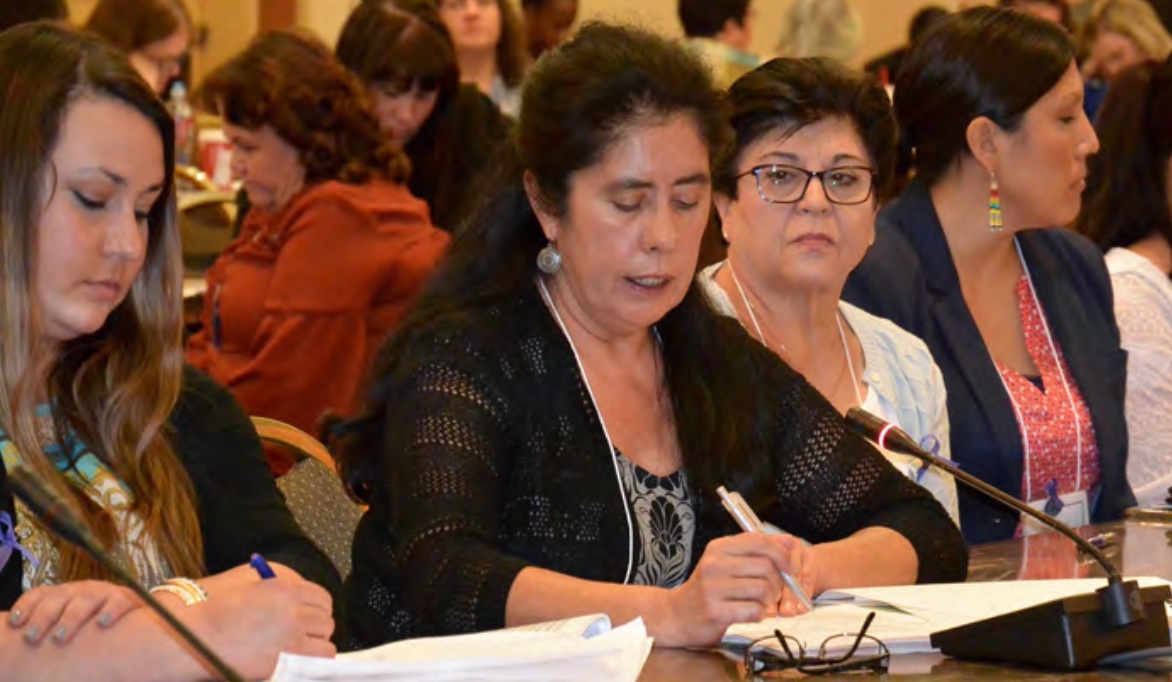A VAWA to Protect All Victims
In the ongoing effort to enhance the response to violence against Native women and implement the VAWA provisions, tribal leaders and advocates providing services to Native women struggle with complicated existing federal Indian law. VAWA was first enacted in 1994
in response to the increased awareness of violence against women as a national issue creating serious consequences for the United States, including Native women and Indians tribes. Today, more than 20 years later, VAWA has not reached all Indian tribes and tribal victims.
While full implementation of VAWA has taken many jurisdictions years, Indian tribes face added challenges and barriers in their efforts. Federal Indian law is frequently referred to as a maze, and sorting through the layers and intersections of these laws often delays providing Native women the same protections afforded other women in the United States. These added challenges are troublesome and ironic in light of the federal responsibilities to Indian tribes established by treaties, executive orders, congressional acts, and Supreme Court cases.
Further complicating the implementation of VAWA are specific federal laws enacted in the past without the insight and current understanding of violence against women as a public policy and safety issue. In reviewing VAWA 2013 implementation across Indian tribes, the tribes that entered into land claims settlement acts decades ago appear to not have benefitted from some of the lifesaving reforms.
VAWA and Self Government

Throughout VAWA, the original passed in 1994 and each reauthorization, Congress recognized the sovereign authority of Indian tribes. In addition, to the general provisions of VAWA, Congress enacted a specific title for Indian tribes when it reauthorized the Act in 2005: Title IX. Safety for Indian Women. “Indian tribes have the inherent authority to self government and this authority is essential to safeguarding the lives of Native women,” said Terri Henry, Co-Chair of the NCAI Task Force on Violence Against Women. “Each Indian tribe determines and responds to domestic violence according to its own unique set of laws, traditions, culture, and beliefs, and perhaps most important to the VAWA context the manner responsive to the needs of our women.”
Legislatively, Congress has recognized the essential role of Indian tribes under VAWA for more than 20 years. “The second purpose area for the VAWA tribal title of 2005 is pointedly clear on the issue of sovereignty,” said Henry. “It states as one of the three purposes of the title—to strengthen the capacity of Indian tribes to exercise their sovereign authority to respond to violent crimes committed against Indian women.” Under VAWA 2013, Congress again recognized the essential role of Indian tribes in responding to domestic violence when it restored criminal jurisdiction over non-Indians in cases of domestic violence.
This pattern under VAWA finds inconsistency with some previous Congressional acts addressing tribal land claims. Indian land claims settlement acts span the time frame of 1978–2006; some contain language of concern regarding how tribes may govern and impact the tribal response specifically in cases of domestic violence. Each settlement is specific to a tribe, and while Congress provided language allowing for future amendment, reaching such an agreement with the state is often complicated.
Immediate and Local Response Is a Tribal Response
Significantly, national experts recognize the importance of an immediate community response to cases of domestic violence, and in cases of Native women an immediate response is a local tribal response. The development of tribal services for victims of domestic violence and programs for abusers acknowledge the important role of tribal beliefs, traditions, and ceremonies in the lives of tribal people.
“We are in the best position to respond to cases of domestic violence for the healing of victims and their families and also for accountability for abusers,” said Chief Commander. “Maliseet women have a right to live safely according to their tribal beliefs and when in danger to protection by their tribal government. Similarly, for Maliseet men, the path home to overcome abusive behavior may be our traditional beliefs of respect. This is our responsibility not the state’s or federal government’s.”
In the effort to address domestic violence, sexual assault, stalking, and dating violence in the United States, it is logical that all states, Indian tribes, and territories would possess the same sovereign rights to protect victims and hold offenders accountable. For Indian tribes, inconsistencies exist not only across the country but also within states like Maine. These inconsistencies create barriers for Native women seeking help to stop the violence threatening their physical safety, well-being, and in some cases, life. “Congress specifically stated as a finding under the 2005 Safety for Indian Women Title that the unique legal relationship of the United States to Indian tribes creates a federal trust responsibility to assist tribal governments in safeguarding the lives of Indian women,” said Henry. “This finding provides clear guidance regarding tribal governance specifically on the issue of violence against Native women.”





